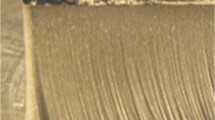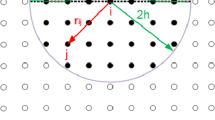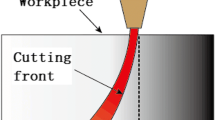Abstract
Virtual machining simulation is becoming an essential and vital tool currently in traditional machining process. With it, a series of trial machining can be avoided. However, the situation is different for high-energy-beam cutting. Till today, there is no accurate virtual cutting simulation tool that can accurately simulate the physical cutting process. As a soft knife, whose shape is changing dynamically, it is a great challenge to accurately define the tool shape and build an accurate 3D geometrical model to be used as a virtual model for simulation. Aiming at abrasive water jet (AWJ) machining, a new method to build a soft knife profile based on energy distribution analysis has been explored in this paper. Through 3D point cloud data of kerf profile, a 3D model of the abrasive water jet profile has been built under different working conditions. To evaluate the effectiveness of the self-defined tool shape, the compensation strategy based on 3D AWJ profile has been carried out in the actual cutting process. The results show that 3D AWJ profile is beneficial to improve the machining accuracy. And this method can be generalized to other high-energy-beam cutting tools such as laser and plasma.






















Similar content being viewed by others
References
Kusiak A (2017) Smart manufacturing must embrace big data. Nature 544:23–25. https://doi.org/10.1038/544023a
Cao X, Zhao G, Xiao W (2022) Digital Twin–oriented real-time cutting simulation for intelligent computer numerical control machining. Proc Inst Mech Eng Part B: J Eng Manuf 236(1-2):5–15. https://doi.org/10.1177/09544054209378
Pan L, Guo X, Luan Y, Wang H (2021) Design and realization of cutting simulation function of digital twin system of CNC machine tool. Proc Comput Sci 183(9):261–266. https://doi.org/10.1016/j.procs.2021.02.057
Fei T, He Z, Liu A, Nee AYC (2019) Digital twin in industry: state-of-the-art. IEEE Trans Ind Inform 15(4):2405–2415. https://doi.org/10.1016/j.procs.2021.02.057
He B, Bai K (2021) Digital twin-based sustainable intelligent manufacturing: a review. Adv Manuf 9:1–21. https://doi.org/10.1007/s40436-020-00302-5
Campos A, Lozoya-Santos J, Vargas-Martínez A, Ramirez-Mendoza RA, Morales-Menendez R (2019) Digital twin applications: a review. AMCA
Wang M, Ma Y, Liu F (2022) A novel virtual cutting method for deformable objects using high-order elements combined with mesh optimisation. Int J Med Robot 18(5):e2423. https://doi.org/10.1002/rcs.2423
Liu X, Liang Z, Wen G, Yuan X (2019) Waterjet machining and research developments: a review. Int J Adv Manuf Technol 102:1257–1335. https://doi.org/10.1007/s00170-018-3094-3
Daniel K (2014) Comparison metal water jet cutting with laser and plasma cutting. Proc Eng 69:838–843. https://doi.org/10.1016/j.proeng.2014.03.061
Hashish M (2015) WaterJet Machining Process. In: Nee A (ed) Handbook of Manufacturing Engineering and Technology. Springer, London. https://doi.org/10.1007/978-1-4471-4670-4_75
Llanto JM, Tolouei-Rad M, Vafadar A, Aamir M (2021) Recent progress trend on abrasive waterjet cutting of metallic materials: a review. Appl Sci 11(8):3344. https://doi.org/10.3390/app11083344
Zeng J, Munoz JP (1994) Intelligent automation of AWJ cutting for efficient production. In: Proceeding of the 12th International Conference on Jet Cutting Technology. BHRA, Rouen, pp 401–408
Hashish M (2007) Benefits of dynamic waterjet angle compensation. 2007 American WJTA Conference and Expo, Houston, Texas, USA
Hlaváˇc LM (2009) Investigation of the abrasive water jet trajectory curvature inside the kerf. J Mater Process Technol 209:4154–4161. https://doi.org/10.1016/j.jmatprotec.2008.10.009
Karthik K, Sundarsingh DS, Harivignesh M, Karthick RG, Praveen M (2021) Optimization of machining parameters in abrasive water jet cutting of stainless steel 304. Mater Today Proc 46:1384–1389. https://doi.org/10.1016/j.matpr.2021.02.489
Wang S, Hu D, Yang F, Lin P (2021) Investigation on kerf taper in abrasive waterjet machining of aluminium alloy 6061-T6. J Mater Res Technol 15:427–433. https://doi.org/10.1016/j.jmrt.2021.08.012
Llanto JM, Vafadar A, Aamir M, Tolouei-Rad M (2021) Analysis and optimization of process parameters in abrasive waterjet contour cutting of AISI 304L. Metals 11(9):1362. https://doi.org/10.3390/met11091362
Hlaváč LM, Annoni MPG, Hlaváčová IM, Arleo F, Viganò F, Štefek A (2021) Abrasive waterjet (AWJ) forces—potential indicators of machining quality. Materials 14(12):3309. https://doi.org/10.3390/ma14123309
Natarajan Y, Murugesan PK, Mohan M, Khan SALA (2020) Abrasive water jet machining process: a state of art of review. J Manuf Process 49:271–322. https://doi.org/10.1016/j.jmapro.2019.11.030
CGTech (2012) VERICUT 7.2: adding power and simplicity where you want it!. https://www.cgtech.com/vericut-7-2.html, July 27, 2012. [accessed 15 March 2023]
Henning A (1997) Computer aided manufacturing for three-dimensional abrasive water jet machining. In: Proceedings of the 9th American Waterjet Conference, Dearborn, Michigan, pp 729–742
Currie IG (2016) Fundamental mechanics of fluids. CRC press
Bogusławski L, Popiel C (1979) Flow structure of the free round turbulent jet in the initial region. J Fluid Mech 90(3):531–539. https://doi.org/10.1017/S0022112079002378
Chen FL, Siores E (2001) The effect of cutting jet variation on striation formation in abrasive water jet cutting. Int J Mach Tools Manuf 41(10):1479–1486. https://doi.org/10.1016/S0890-6955(01)00013-X
Balz R, Heiniger KC (2011) Determination of spatial velocity distributions of abrasive particles in abrasive water jets using laser-induced fluorescence under real conditions. In: Proceedings of 16th WJTA-IMCA Conference and Expo. WJTA-IMCA, Houston, TX
Ke Y, Mao G, Ouyang D, Liu Z (2017) Analysis of abrasive distribution for high pressure abrasive waterjet. Mining Metall Eng 37(5):30–34. https://doi.org/10.3969/j.issn.0253-6099.2017.05.007
Chen J, Yuan Y, Gao H, Zhou T, Wu Z (2022) Predictive modeling approach for the jet lag in multi-pass cutting of thick materials using abrasive waterjet. J Manuf Process 83:143–156. https://doi.org/10.1016/j.jmapro.2022.08.059
Chen M, Zhang S, Zeng J (2020) Exploring the effectiveness of a self-defined virtual cutting method with a “soft knife”. Int J Adv Manuf Technol 106(6). https://doi.org/10.1007/s00170-019-04803-x
Zeng J, Kim TJ (1992) Development of an abrasive waterjet kerf cutting model for brittle materials. In: Lichtarowicz A (ed) Jet cutting technology. Fluid mechanics and its applications, vol 13. Springer, Dordrecht. https://doi.org/10.1007/978-94-011-2678-6_33
Zhang S, Ji L, Wu Y, Chen M (2020) Zhou W (2020) Exploring a new method to obtain the 3D abrasive water jet profile. Int J Adv Manuf Technol 107:4797–4809. https://doi.org/10.1007/s00170-020-05185-1
Fitzgibbon A, Pilu M, Fisher RB (1999) Direct least square fitting of ellipses. IEEE Trans Pattern Anal Mach Intell 21(5):476–480. https://doi.org/10.1109/34.765658
Zeng J (2007) Determination of machinability and abrasive cutting properties in AWJ cutting. 2007 American WJTA Conference and Expo, Houston, Texas, pp 19–21
Acknowledgements
This work was supported by the National Natural Science Foundation of China [grant number 52075313]; and the Science and Technology Innovation 2030-Key Project of New Generation Artificial Intelligence, China [grant number 2021ZD0113102].
Funding
This work was supported by the National Natural Science Foundation of China (grant number 52075313) and the Science and Technology Innovation 2030-Key Project of New Generation Artificial Intelligence, China (grant number 2021ZD0113102).
Author information
Authors and Affiliations
Contributions
All authors contributed to the study conception and design. Material preparation, data collection, and analysis were performed by MC and SZ. The first draft of the manuscript was written by MC, and all authors commented on previous versions of the manuscript. All authors read and approved the final manuscript.
Corresponding author
Ethics declarations
Competing interests
The authors declare no competing interests.
Additional information
Publisher’s note
Springer Nature remains neutral with regard to jurisdictional claims in published maps and institutional affiliations.
Rights and permissions
Springer Nature or its licensor (e.g. a society or other partner) holds exclusive rights to this article under a publishing agreement with the author(s) or other rightsholder(s); author self-archiving of the accepted manuscript version of this article is solely governed by the terms of such publishing agreement and applicable law.
About this article
Cite this article
Chen, M., Zhang, S., Wu, Y. et al. Build an accurate 3D geometrical model of a soft knife profile of abrasive water jet. Int J Adv Manuf Technol 129, 2475–2489 (2023). https://doi.org/10.1007/s00170-023-12428-4
Received:
Accepted:
Published:
Issue Date:
DOI: https://doi.org/10.1007/s00170-023-12428-4




